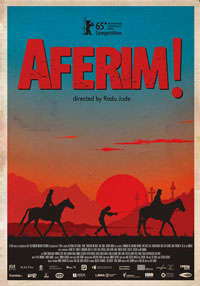
Set in Eastern Europe in 1835, co-writer/director Radu Jude’s Aferim!, Romania’s Official Entry for the 88th Best Foreign Language Film Academy Award, is – at least for American viewers – reminiscent of Westerns. The plot revolves around two males on horseback scouring the countryside, hunting for a missing person. With this plot you’d think Aferim! is Romanian for “After Him!” but it actually can be translated as “Bravo!”
The horse opera Aferim! reminds me most of is John Ford’s 1956 classic The Searchers, wherein John Wayne plays ex-Confederate soldier Ethan Edwards, who returns home to West Texas after the Civil War and proceeds to roam around Monument Valley and environs with Jeffrey Hunter on an epic odyssey to find Ethan’s niece, Debbie Edwards (Natalie Wood), who was kidnapped years earlier by Comanches. However, in Aferim! lawman Costandin (Teodor Corban) and his son Ionita (Mihai Comanoiu) are hot on the trail of an escaped slave, Carfin Pandolean (Cuzin Toma), in order to return him to the nobleman who owns him.
There is another point The Searchers and Aferim! have in common: the element of racism. In the former the crux is whether, after so many years in captivity since she was a child, Debbie has “gone Native” or will return to “civilization” and live according to the white man’s ways. In Aferim!, Carfin is enslaved because he is a member of a despised minority group, the so-called “Gypsies.” Along with the Jews, these people were among those the Nazis would later earmarkfor racial extermination during the genocidal Holocaust.
One can see the roots of this hatred in Aferim!, with the abysmal, oppressive mistreatment of these abused human beings living in bondage. Fortunately, they survived the slings and arrows of outrageous misfortune perpetrated against them in early 19th-century Romania and on through the “Final Solution.” But they are still often Europe’s outcasts and the name “Gypsy” is no longer considered to be culturally correct. Stereotyped as thieves – especially of children (as in the case of Debbie in The Searchers) – the slang term “gypped” is probably derived from bigoted tropes about people now more properly known as the Roma. Aferim! may provide insight into how the Roma were regarded and dealt with in 1835 Romania, but it also raises disturbing questions about the Roma’s plight and situation today in the supposedly more enlightened European Union – and may even shed light on the way the current tide of refugees from war-torn countries have been treated by contemporary Europeans.
Aferim! has a number of genre conventions of the Western, from horseplay to gunplay to saloon girls to sprawling landscapes – although these Badlands are in the Balkans. One could argue that the Romanian-set Aferim! should be called an “Eastern.” In any case, with its commentary on class and race Aferim! and heartbreaking cruelty, it is a compelling drama from which it’s hard to avert one’s eyes.
Jude’s film is welldirected and shot in atmospheric black and white by director of photography Marius Panduru. Aferim! won the Silver Bear for Best Director at the 2015 Berlin International Film Festival and was the Official Selection at the 2015 Tribeca Film Festival. The L.A.-based South East European Film Festival (SEEFEST)has previously screened some of Jude’s films, including The Tube with a Hat, Shadow of a Cloud, and co-presented with AFI Everybody in Our Family. (This year’s 11th annual SEEFEST takes place in L.A. from April 28-May 5.)
Aferim! theatrically opens in Los Angeles, New York and San Francisco on January 22. A national release will follow.












Comments